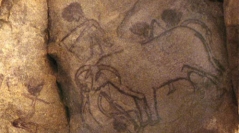

 Comptes Rendus Palevol
5 (1-2) - Pages 421-427
Comptes Rendus Palevol
5 (1-2) - Pages 421-427In the Early Holocene, a culture called Saharo-Sudanese Neolithic developed in the central Sahara. Earlier than 9120–8450 cal. BC, they made use of arrowheads, grinding material and many potteries. They have been related to Round Heads paintings. The pictorial expression, archaeological and environmental data suggests particular relationships to some plants and animals (cattle, Barbary sheep and probably antelope). Cattle breeding generated brilliant pastoral culture in the middle Holocene, as for the farming practice there is no evidence, before the 3rd millennium, of mill cultivation.
Domestication, Central Sahara, Holocene, Neolithic, pottery, Bos